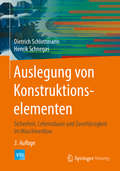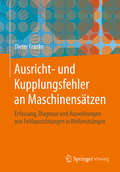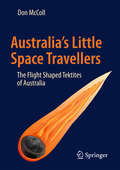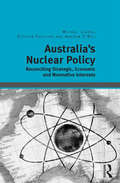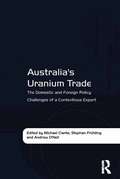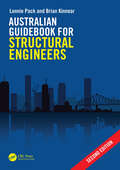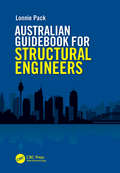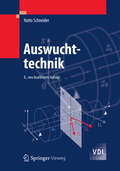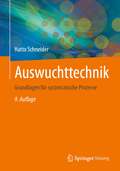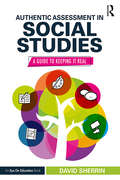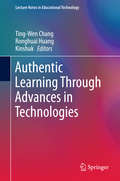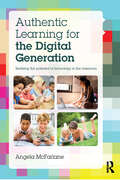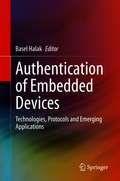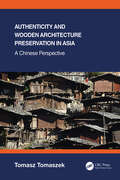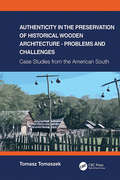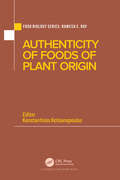- Table View
- List View
Auslegung von Konstruktionselementen: Sicherheit, Lebensdauer und Zuverlässigkeit im Maschinenbau
by Dietrich Schlottmann Henrik SchnegasDieses Fachbuch befasst sich mit der Auslegung von Maschinenelementen und vermittelt die Grundlagen der Berechnung einer Lebensdauer bei Ermüdung, Verschleiß und anderen Schädigungsprozessen sowie der Ermittlung der Zuverlässigkeit bzw. Schadenswahrscheinlichkeit maschinenbaulicher Systeme. Das Werk vermittelt einen direkten Zusammenhang zwischen klassischer Sicherheitsberechnung, Lebensdauerbestimmung im Sinne der Betriebsfestigkeitslehre sowie der aktuellen Zuverlässigkeit und Schadenswahrscheinlichkeit für Risikobewertung und Instandhaltung. Veranschaulicht wird, welche Rolle die Kosten als Bestandteil des Product Lifecycle Managements spielen, ergänzt durch Werkzeuge und Algorithmen für die statistische Auswertung und numerische Beschreibung von Lebensdauer, Zuverlässigkeit und Ausfallwahrscheinlichkeit. Übungsaufgaben für die statistische Versuchsauswertung, Verschleißbeschreibungen, Verfahren zur Kollektivermittlung und eine weitgefasste Datensammlung im Anhang bieten wertvolle Hilfen für den Konstruktionsalltag.
Auslegung von Konstruktionselementen: Sicherheit, Lebensdauer und Zuverlässigkeit im Maschinenbau (VDI-Buch #40)
by Dietrich Schlottmann Henrik SchnegasDieses Fachbuch befasst sich mit der Auslegung von Maschinenelementen. Die Autoren vermitteln dazu die Grundlagen der Berechnung einer ,,Sicherheit", der Berechnung einer Lebensdauer bei Erm#65533;dung, Verschlei#65533; und anderen Sch#65533;digungsprozessen und der Ermittlung der Zuverl#65533;ssigkeit bzw. Schadenswahrscheinlichkeit maschinenbaulicher Systeme. Leser entdecken in dem Buch einen direkten Zusammenhang zwischen klassischer Sicherheitsberechnung, Lebensdauerbestimmung im Sinne der Betriebsfestigkeitslehre sowie der aktuellen Zuverl#65533;ssigkeit und Schadenswahrscheinlichkeit f#65533;r Risikobewertung und Instandhaltung. Veranschaulicht wird, welche Rolle die Kosten als Bestandteil des Product Lifecycle Managements spielen. In der dritten Auflage wurde die klassische Sicherheit um eine Produktsicherheit unter dem Aspekt einer Risiko- und Gefahrenanalyse erweitert. Werkzeuge und Algorithmen f#65533;r die statistische Auswertung und numerische Beschreibung von Lebensdauer, Zuverl#65533;ssigkeit und Ausfallwahrscheinlichkeit wurden erg#65533;nzt. Neue #65533;bungsaufgaben f#65533;r die statistische Versuchsauswertung, Verschlei#65533;beschreibung, erg#65533;nzte Verfahren zur Kollektivermittlung und eine erweiterte Datensammlung im Anhang sind wertvolle Hilfen f#65533;r den Konstrukteur.
Ausricht- und Kupplungsfehler an Maschinensätzen: Erfassung, Diagnose und Auswirkungen von Fehlausrichtungen in Wellensträngen
by Dieter FrankeBeim Maschinenausrichten an gekuppelten Maschinensätzen gibt es einen breiten Anwenderkreis, der mit Messmitteln oder Messgeräten diese geometrisch nur scheinbar einfache Aufgabe löst. Nicht ausreichend ist häufig der fachliche Hintergrund der Techniker, Meister und Ingenieure, vor allem zu den vielfältigen Auswirkungen und zur Diagnose von Fehlausrichtungen im Betrieb.Um eine Ausrichtmessung zuverlässig ausführen, begleiten oder vermitteln zu können, wird der Hauptzielgruppe ein Überblick über die praktischen Methoden vermittelt. In der VDI 2627 wurden diese Inhalte an Getrieben ansatzweise beschrieben; der Autor trug zur Verbesserung einer Neuerscheinung dieser Richtlinie bei.Hier setzt auch die Buchreihe "Einführung in die Maschinendiagnose" an. Vom physikalischen Hintergrund bis zur praktischen Anwendung werden Grundlagen und Erfahrungen leicht verständlich dargestellt und mit praktischen Beispielen illustriert.Die vertiefte, umfassende Diagnose von Bauteilschäden von der "Initial- bis zur Wurzelursache" über die Behandlung praktischer Fehlerquellen an Maschinen bis zu deren Abhilfe und echten Vorbeugung werden in dieser Buchreihe behandelt.
Austenitic TRIP/TWIP Steels and Steel-Zirconia Composites: Design of Tough, Transformation-Strengthened Composites and Structures (Springer Series in Materials Science #298)
by Horst Biermann Christos G. AnezirisThis open access book presents a collection of the most up-to-date research results in the field of steel development with a focus on pioneering alloy concepts that result in previously unattainable materials properties. Specifically, it gives a detailed overview of the marriage of high-performance steels of the highest strength and form-ability with damage-tolerant zirconia ceramics by innovative manufacturing technologies, thereby yielding a new class of high-performance composite materials. This book describes how new high-alloy stainless TRIP/TWIP steels (TRIP: TRansformation-Induced Plasticity, TWIP: TWinning-induced Plasticity) are combined with zirconium dioxide ceramics in powder metallurgical routes and via melt infiltration to form novel TRIP-matrix composites. This work also provides a timely perspective on new compact and damage-tolerant composite materials, filigree light-weight structures as well as gradient materials, and a close understanding of the mechanisms of the phase transformations.With a detailed application analysis of state-of-the-art methods in spatial and temporal high-resolution structural analysis, in combination with advanced simulation and modelling, this edited volume is ideal for researchers and engineers working in modern steel development, as well as for graduate students of metallurgy and materials science and engineering.
Australia's Little Space Travellers: The Flight Shaped Tektites of Australia
by Don MccollThis book provides a showcase for the incredibly well-preserved flight-textured tektites of southern Australia, which are the world's finest known examples. It provides an overview of their forms and flight features, which can be expected to appear, at least in part, on any objects falling from space. Some of these specimens are so perfectly shaped that it is hard to believe that they have been buried in the recent strata of Australia for 770,000 years. It also discusses the history of the story of their incredible flight into space and return becoming widely accepted, which led to them being recognized as space travelers. Further, it describes their classical shapes and offers an explanation of how each developed. It provides collectors, meteoriticists, and museum curators with insights into the astounding forms of Australian tektites produced by hypersonic flight.
Australia's Nuclear Policy: Reconciling Strategic, Economic and Normative Interests
by Michael Clarke Stephan FrühlingAustralia’s Nuclear Policy: Reconciling Strategic, Economic and Normative Interests critically re-evaluates Australia’s engagement with nuclear weapons, nuclear power and the nuclear fuel cycle since the dawn of the nuclear age. The authors develop a holistic conception of ’nuclear policy’ that extends across the three distinct but related spheres - strategic, economic and normative - that have arisen from the basic ’dual-use’ dilemma of nuclear technology. Existing scholarship on Australia’s nuclear policy has generally grappled with each of these spheres in isolation. In a fresh evaluation of the field, the authors investigate the broader aims of Australian nuclear policy and detail how successive Australian governments have engaged with nuclear issues since 1945. Through its holistic approach, the book demonstrates the logic of seemingly conflicting policy positions at the heart of Australian nuclear policy, including simultaneous reliance on US extended deterrence and the pursuit of nuclear disarmament. Such apparent contradictions highlight the complex relationships between different ends and means of nuclear policy. How successive Australian governments of different political shades have attempted to reconcile these in their nuclear policy over time is a central part of the history and future of Australia’s engagement with the nuclear fuel cycle.
Australia's Uranium Trade: The Domestic and Foreign Policy Challenges of a Contentious Export
by Stephan FrühlingAustralia's Uranium Trade explores why the export of uranium remains a highly controversial issue in Australia and how this affects Australia's engagement with the strategic, regime and market realms of international nuclear affairs. The book focuses on the key challenges facing Australian policy makers in a twenty-first century context where civilian nuclear energy consumption is expanding significantly while at the same time the international nuclear nonproliferation regime is subject to increasing, and unprecedented, pressures. By focusing on Australia as a prominent case study, the book is concerned with how a traditionally strong supporter of the international nuclear nonproliferation regime is attempting to recalibrate its interest in maximizing the economic and diplomatic benefits of increased uranium exports during a period of flux in the strategic, regime and market realms of nuclear affairs. Australia's Uranium Trade provides broader lessons for how - indeed whether - nuclear suppliers worldwide are adapting to the changing nuclear environment internationally.
Australian Battalion Commanders In The Second World War
by Garth PrattenThis book explores the background, role and conduct of the commanding officers of Australian infantry battalions in World War II.
Australian Contributions to Strategic and Military Geography (Advances In Military Geosciences Ser.)
by Stuart Pearson Jane L. Holloway Richard ThackwayDrawing from military geography’s spatial roots, its embrace of dynamic systems, and integration of human and biophysical environments, this book helps in understanding the value of analyzing patterns, processes and systems, and cross-scale and multi-disciplinary ways of acting in a complex world, while making the case for a resurgence of strategic and military geography in Australia. Here, leading experts demonstrate that geography retains its relevance in clarifying the scale and dynamics of defense activities in assessments of the international, regional, national, and site impacts of changes in physical, cyber and human geographies. The cases presented show Australia contributing to a growing strategic and military geography.
Australian Guidebook for Structural Engineers
by Lonnie Pack Brian KinnearThis guidebook is a practical and essential tool covering all the necessary steps for structural design engineers to create detailed and accurate calculations in accordance with Australian and international standards.General project requirements are explained in terms of project management and document control. Calculation methods and details are shown for actions (wind, seismic, dead and live loads). Design details are then provided for steel, concrete, timber, and geotechnical calculations (footings, piles, retaining walls, etc.). Detailed worked example calculations are included throughout the text, as well as typical CAD details for design drawings. Design items are explained for typical items of equipment found across various industries (e.g. piping, vessels, lifting, machine foundations, access, composite structures, bunds, and more). Design aids are provided, including guides and examples for popular engineering programs (Space Gass, Strand7 and Rhinoceros 3D). Comprehensive capacity tables are also included for steel and concrete elements.This edition has been updated to include the latest design requirements from Australian Standards, including Steel Structures (AS 4100–2020), Concrete Structures (AS 3600–2018) (including steel fibre reinforced concrete slabs), Earthquake Actions (AS 1170.4–2024), and basic requirements from Timber Structures (AS 1720.1–2010). Requirements from many more Australian Standards and international standards are also provided in the context of typical design projects.
Australian Guidebook for Structural Engineers
by Lonnie PackThis guidebook is a practical and essential tool providing everything necessary for structural design engineers to create detailed and accurate calculations. Basic information is provided for steel, concrete and geotechnical design in accordance with Australian and international standards. Detailed design items are also provided, especially relevant to the mining and oil and gas industries. Examples include pipe supports, lifting analysis and dynamic machine foundation design. Steel theory is presented with information on fabrication, transportation and costing, along with member, connection, and anchor design. Concrete design includes information on construction costs, as well as detailed calculations ranging from a simple beam design to the manual production of circular column interaction diagrams. For geotechnics, simple guidance is given on the manual production and code compliance of calculations for items such as pad footings, piles, retaining walls, and slabs. Each chapter also includes recommended drafting details to aid in the creation of design drawings. More generally, highly useful aids for design engineers include section calculations and force diagrams. Capacity tables cover real-world items such as various slab thicknesses with a range of reinforcing options, commonly used steel sections, and lifting lug capacities. Calculations are given for wind, seismic, vehicular, piping, and other loads. User guides are included for Space Gass and Strand7, including a non-linear analysis example for lifting lug design. Users are also directed to popular vendor catalogues to acquire commonly used items, such as steel sections, handrails, grating, grouts and lifting devices. This guidebook supports practicing engineers in the development of detailed designs and refinement of their engineering skill and knowledge.
Australian Native Plants: Cultivation and Uses in the Health and Food Industries (Traditional Herbal Medicines for Modern Times)
by Yasmina Sultanbawa and Fazal SultanbawaAustralian Native Plants: Cultivation and Uses in the Health and Food Industries provides a comprehensive overview of native food crops commercially grown in Australia that possess nutritional and health properties largely unknown on a global basis. These native foods have been consumed traditionally, have a unique flavor diversity, offer significant health promoting effects, and contain useful functional properties. Australian native plant foods have also been identified for their promising antioxidant and antimicrobial properties that have considerable commercial potential. This book is divided into three parts: The first part reviews the cultivation and production of many Australian native plants (ANP), including Anise Myrtle, Bush Tomato, Desert Raisin, Davidson’s Plum, Desert Limes, Australian Finger Lime, Kakadu Plum, Lemon Aspen, Lemon Myrtle, Muntries, Native Pepper, Quandong, Riberry, and Wattle Seed. It then examines the food and health applications of ANP and discusses alternative medicines based on aboriginal traditional knowledge and culture, nutritional characteristics, and bioactive compounds in ANP. In addition, it reviews the anti-obesity and anti-inflammatory properties of ANP and discusses food preservation, antimicrobial activity of ANP, and unique flavors from Australian native plants. The third section covers the commercial applications of ANP. It focuses on native Australian plant extracts and cosmetic applications, processing of native plant foods and ingredients, quality changes during packaging, and storage of Australian native herbs. The final few chapters look into the importance of value chains that connect producers and consumers of native plant foods, new market opportunities for Australian indigenous food plants, and the safety of using native foods as ingredients in the health and food sectors.
Australian Precious Opal
by Archie KalokerinosThe magnificent splendour of the Australian opal that has fascinated the world for almost a century is still clad in a mysterious veil of fear and superstition whose only explanation is the lack of knowledge. This book attempts to clear the cloud to some extent to the enjoyment of the readers.
Australia’s Energy Transition: Balancing Competing Demands and Consumer Roles
by Glen CurrieThis book studies Australia, a country characterized by the highest concentration of domestic photovoltaic systems. In addition, the high level of solar energy that Australia receives makes these systems a significant part of its energy mix. International electricity system managers take note; your systems are heading this way. The energy transition is an emerging field, and few texts have been published that can help energy planners as this book does. The research presented is sociotechnical in nature, and reveals that the main challenge in the energy transition is its emerging social role. Very few works combine the social and technical fields of energy. Given its scope, the book will appeal to readers interested in policy, regulation, and energy systems, including government employees involved in energy system management all around the world.
Auswuchttechnik (VDI-Buch)
by Hatto SchneiderFür die Qualitätssicherung von Rotoren ist das Auswuchten ein unverzichtbarer Schritt. Dabei verändern sich mit jeder Weiterentwicklung der Rotoren die Anforderungen an die Auswuchttechnik. Wichtige Prinzipien des Auswuchtens werden in dem Buch erklärt. Es dient als Werkzeug, um die stets neu auftretenden Probleme beim Auswuchten sachgerecht und wirtschaftlich lösen zu können. In der 8. Auflage wird die neue Norm DIN ISO 19499 ausführlich erläutert. Die beabsichtigten Bearbeitungen aller Auswuchtnormen vonseiten des DIN werden erstmals beschrieben.
Auswuchttechnik: Grundlagen für systematische Prozesse
by Hatto SchneiderFür die Qualitätssicherung von Rotoren ist das Auswuchten ein unverzichtbarer Schritt. Dabei verändern sich mit jeder Weiterentwicklung der Rotoren die Anforderungen an die Auswuchttechnik. Wichtige Prinzipien des Auswuchtens werden in dem Buch erklärt. Es dient als Werkzeug, um die stets neu auftretenden Probleme beim Auswuchten sachgerecht und wirtschaftlich lösen zu können. In der 8. Auflage wird die neue Norm DIN ISO 19499 ausführlich erläutert. Die beabsichtigten Bearbeitungen aller Auswuchtnormen vonseiten des DIN werden erstmals beschrieben.
Authentic Assessment in Social Studies: A Guide to Keeping it Real
by David SherrinThis engaging book will show you how to move beyond tests and essay writing to implement authentic assessments in your middle or high school social studies classroom. Award-winning teacher David Sherrin explains the value of authentic assessments and offers practical ways to get started and dive deeper in your own practice. You&’ll be encouraged and inspired by the real-life stories of classroom successes and failures that illustrate the points throughout the book. The chapters cover a range of categories, including different types of written, creative, and civic action assessments. <P><P> The book includes: <li>planning charts and rubrics showing how to use, grade, and give feedback on assessments so they truly aid student learning and progress <li>specific examples, useful tips, and ready-to-go instructions that you can use immediately with your class <li>open-ended assessments encourage scaffolding or adaptation for individual or group work to fit your classroom needs <p><P>You will learn how to personalize instruction and provide students with avenues for creativity and the types of learning experiences they need to be prepared for a complex world.
Authentic Learning Through Advances in Technologies (Lecture Notes in Educational Technology)
by Kinshuk Ronghuai Huang Ting-Wen ChangThis book introduces the advanced technologies used for authentic learning, an educational term that refers to a variety of techniques focusing on how students apply the skills and knowledge acquired in school in real-world situations. In the meanwhile, it presents the latest trends and future developments in learning design, learning environment and assessment for authentic learning using advances in technology, this book discusses how technology supports authentic learning and what makes it effective.
Authentic Learning for the Digital Generation: Realising the potential of technology in the classroom
by Angela McFarlaneWhy should we use technology to support learning? Where does the responsibility lie to prepare young people to be active and successful cybercitizens? Can we go on confiscating pupils’ smartphones indefinitely? Authentic Learning for the Digital Generation is a vital examination of young people’s use of personal devices, online creative communities and digital gaming. It calls into question the idea of the ‘digital native’ and shows clearly that the majority of young users need help and support in order to benefit from the rich learning potential of personal, mobile and online technology use. Written by a leading authority on the role of digital technologies in education, it looks in detail at the practice and implications of learning using personal devices, collaborative online spaces, learning platforms, user generated content and digital games. In particular, approaches to solving problems, building knowledge, manipulating data and creating texts are examined. It offers clear strategies, a vision for what effects on learning we might reasonably expect when children are given access to different types of technology, and explores the challenges of managing these practices in the classroom. Authentic Learning for the Digital Generation offers careful analysis at a time when there is much discussion about young people emerging from school unprepared for the world of work and often struggling to manage their personal relationships as they are exposed to strong content and harsh criticism online. It considers what we know of childhood experience in a digital world and offers ways in which schools and teachers can embrace the opportunity presented by ubiquitous ownership of connected, digital devices to enrich and deepen learning.
Authentic Virtual World Education: Facilitating Cultural Engagement and Creativity
by Sue Gregory Denise WoodThe book presents the possibilities and realities of virtual worlds in education through the application of 3D virtual worlds to support authentic learning, creativity, learner engagement and cultural diversity in higher education. It includes a unique variety of cross disciplinary approaches to research, teaching and learning in a virtual world, including analysis of data from the experiences of students in education, law, Chinese language, sustainability, computer architecture, business, health and the Arts. The book provides unique learning experiences that have celebrated the rich media of virtual world environments through the utilisation of affordances such as simulation, bots, synchronous interaction, machinima and games. The perspectives come from Australia and New Zealand higher education academics but transferable to any higher educational institution in the sector, worldwide, and is significant to various disciplines in the higher education field.
Authentication Codes and Combinatorial Designs (Discrete Mathematics and Its Applications)
by Dingyi PeiResearchers and practitioners of cryptography and information security are constantly challenged to respond to new attacks and threats to information systems. Authentication Codes and Combinatorial Designs presents new findings and original work on perfect authentication codes characterized in terms of combinatorial designs, namely strong partially
Authentication of Embedded Devices: Technologies, Protocols and Emerging Applications
by Basel HalakThis book provides comprehensive coverage of state-of-the-art integrated circuit authentication techniques, including technologies, protocols and emerging applications.The authors first discuss emerging solutions for embedding unforgeable identifies into electronics devices, using techniques such as IC fingerprinting, physically unclonable functions and voltage-over-scaling. Coverage then turns to authentications protocols, with a special focus on resource-constrained devices, first giving an overview of the limitation of existing solutions and then presenting a number of new protocols, which provide better physical security and lower energy dissipation. The third part of the book focuses on emerging security applications for authentication schemes, including securing hardware supply chains, hardware-based device attestation and GPS spoofing attack detection and survival.Provides deep insight into the security threats undermining existing integrated circuit authentication techniques;Includes an in-depth discussion of the emerging technologies used to embed unforgeable identifies into electronics systems;Offers a comprehensive summary of existing authentication protocols and their limitations;Describes state-of-the-art authentication protocols that provide better physical security and more efficient energy consumption;Includes detailed case studies on the emerging applications of IC authentication schemes.
Authenticity and Wooden Architecture Preservation in Asia – a Chinese perspective
by Tomasz TomaszekThe tradition of Chinese wooden architecture dates back to ancient times. The construction solutions developed in this country over the centuries enchant with their refined character, while the historical wooden structures delight future generations with their dignity and aesthetic excellence. China`s wooden architecture, deeply rooted in its spiritual and religious traditions, is undoubtedly the pinnacle of this type of building in Asian culture. At the same time, it is a testimony to the national identity and reflects the specificity of the country`s material heritage. The accelerated social and economic changes in China and the constantly advancing globalization of the world have contributed to this country’s assimilation of Western concepts related to the protection of cultural heritage. The issue of authenticity in the preservation of wooden built heritage proved particularly problematic. This book brings closer the theoretical understanding and practical application of the idea of authenticity from Chinese perspective. To do this, the issue of living heritage and the reception and understanding of traditional Chinese wooden architecture and its preservation as a direct materialization of Chinese religious and philosophical traditions is discussed. The above topics are treated within the cyclic concept of time, i.e. in terms of progress and repetition, with preservation being understood as a religious practice. Finally, trends in the preservation of wooden heritage in present-day China are mentioned, including new attempts to interpret the tradition and the reinvention of the tradition of wooden building. The book aims to contribute to the understanding of the protection of wooden architectural heritage in China from a new perspective, and will be of particular interest to academics and professionals interested in or involved in the preservation of built wooden heritage. ‘(…) a highly valuable contribution to the field of wooden architecture protection and preservation’, Xiaoming Zhu (Tongji University, Shanghai, China) This book ‘(…) successfully explains the inheritance characteristics of Chinese wooden architectures from the perspective of cultural philosophy for a wide audience (…)’, Yasufumi Uekita, University of Tsukuba, Ibaraki, Japan
Authenticity in the Preservation of Historical Wooden Architecture - Problems and Challenges: Case Studies from the American South
by Tomasz TomaszekHistorical wooden architecture is one of the most unique types of heritage built. Built from organic material, wooden buildings remain in harmony with the natural environment and fascinate future generations with its special charm. Because of its uniqueness, wooden buildings reflect the richness of traditional building solutions developed in different parts of the world. At the same time, this type of building contains the spiritual values that were important to those who built these architectural structures. The main topics of 'Authenticity in Preserving Historical Wooden Architecture - Problems and Challenges' are: (i) The method of protection and preservation of wooden buildings as a form of specific historical interpretation; (ii) The question of reconstruction and translocation of a wooden historical building with regard to the level of authenticity; (iii) The analysis of the essence of historical changes and the methods for maintaining and displaying wooden structures in relation to the requirements that determine their historical and architectural authenticity. Showing a variety of aspects of authenticity of wooden buildings, all demonstrated by specific examples (case studies), 'Authenticity in Preserving Historical Wooden Architecture - Problems and Challenges' presents practical implementations of theoretical findings. Hence, the book contributes to the understanding of wooden architectural heritage from a new perspective. The book will be of particular interest to academics and professionals interested in or involved in the preservation of built wooden heritage.
Authenticity of Foods of Plant Origin (Food Biology Series)
by Konstantinos KotsanopoulosFood is adulterated to increase profit or due to negligence. Adulteration can compromise food safety and quality, and harm consumers. This may undermine consumer trust and the reputation of the food industry. As such, it is very important to monitor, control and detect adulteration. A number of techniques have been developed for the authentication of food and verifying its quality and associated claims. Foods of plant origin are the source of nutrients for billions of people around the globe. Due to the huge variety of plants, and the lack of visual characteristics as a result of processing, advanced techniques are required to detect adulteration. This book reviews the latest developments in the field of authenticity of foods of plant origin, examining concepts such as traceability, and how they are applied to facilitate the support of claims, as well as legislative requirements in the major economies around the world. The basic techniques used nowadays in verifying authenticity of these types of foods are reviewed and discussed, and their applications are summarized. The book also focuses on categories of foods most prone to adulteration attempts due to their characteristics, properties and production methods commonly followed, thus allowing the reader to more easily identify the chapter that is of interest in each case. The book will be of interest to food industrialists, chemists, quality control scientists and technologists, microbiologists, analytical chemists and food physical chemists within the food industry. It is also aimed at academicians who are interested in the authenticity of foods of plant origin and the advancements in the analytical fields that support relevant legal and marketing requirements.

